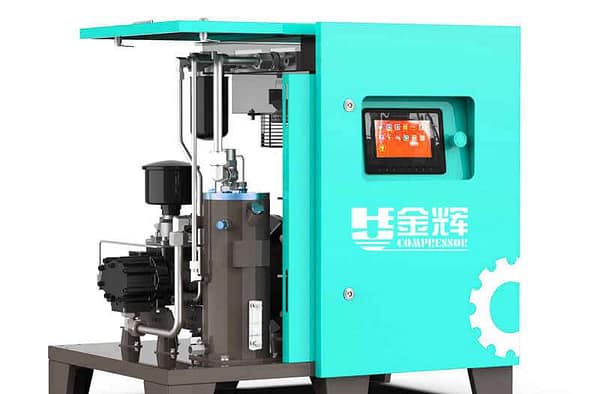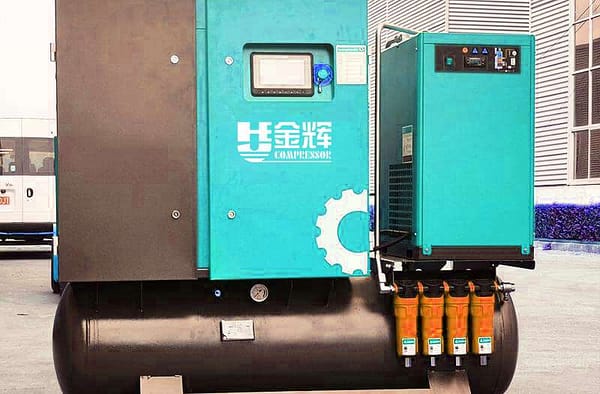
Main classifications of air compressors
There are many types of air compressors, which can be divided according to different core features and application requirements, and the following are the main ways of categorization:
I. According to the principle of work (the most central way of categorization)
This is a fundamental classification based on the principle of gas compression:
-
Positive Displacement.
-
Principle: Increase gas pressure by periodically reducing the confined volume.
-
Features: Wide range of exhaust pressure (low pressure to ultra-high pressure), relatively small flow rate and affected by the speed of rotation, pressure and flow rate relationship is not large.
-
Main types:
-
Reciprocating/Piston.
-
Piston: The most common, mature structure, wide range of pressure. Divided into single-stage, multi-stage compression; single-acting, double-acting; air-cooled, water-cooled.
-
Diaphragm: The compression chamber is isolated from the lubrication system to provide absolutely oil-free air, which is used in food, medicine, precision instrumentation and other occasions with extremely high requirements for cleanliness.
-
-
Rotary:
-
Screw: Mainstream industrial models, divided into oil injection (lubrication, cooling, sealing) and oil-free (dry, water lubrication). High efficiency, relatively low noise and vibration, smooth operation, wide flow range.
-
Sliding Vane: Compact and simple structure, low noise.
-
Scroll: Compact structure, smooth and quiet operation, high efficiency, oil-free design is common. Commonly used in small and medium-sized flow, clean and quiet scenes (such as medical, laboratory, precision manufacturing).
-
Roots Blower: Usually belongs to the category of low-pressure blowers (exhaust pressure generally < 1 bar g), but sometimes also used for low-pressure compressed air delivery. No internal compression, low efficiency.
-
-
-
-
Dynamic (Power/Speed/Turbine).
-
Principle: The kinetic energy is transferred to the gas using a high-speed rotating impeller and then partially converted into pressure energy in the diffuser.
-
Features: Large flow rate (especially in large flow rate has obvious advantages), relatively low exhaust pressure (single-stage or multi-stage up to medium and high pressure), compact structure, continuous and smooth airflow. Efficiency is sensitive to changes in working conditions.
-
Main types:
-
Centrifugal: Mainstream turbocompressor. Acceleration of the gas by centrifugal force of the impeller. Suitable for large flow rates (> 100 m³/min) and medium to high pressures (multi-stage series). High efficiency, relatively simple maintenance, but relatively narrow adjustment range.
-
Axial: Gas is compressed in axial flow. Suitable for very large flows (e.g., large wind tunnels, aircraft engines, large FCC installations). Complex structure and high manufacturing difficulty.
-
-
-
Thermal:
-
Principle: Gas compression using thermal cycles (e.g. Stirling cycle) or injection effects (e.g. steam injection compressors, gas injection compressors).
-
Features: Applications in specific areas (e.g. Stirling engine-driven compressors utilizing waste heat, vacuum obtaining), less so in the field of conventional compressed air.
-
II. According to the lubrication mode
This is critical for air quality and applicable industries:
-
Oil lubricated air compressors (Lubricated).
-
Features: The compression chamber is lubricated, cooled and sealed with lubricating oil (mainly reciprocating piston and oil-injected screw).
-
Air Quality: Outlet air contains oil (relies on high efficiency oil/air separator to reduce oil content to ppm level). Costs are usually low.
-
-
Oil-Free Compressors.
-
Features: No lubricant is used in the compression chamber (or special media such as pure water lubrication, self-lubricating materials are used). Includes oil-free piston, oil-free screw (dry, water lubricated), diaphragm type, scroll type, centrifugal type, axial flow type and so on.
-
Air Quality: Provides Class 0 (ISO 8573-1) true oil-free air to meet the stringent air quality requirements of the food, beverage, pharmaceutical, electronics, medical, chemical and other industries.
-
Cost: Typically high initial investment and some maintenance costs.
-
III. By special design or application requirements
-
Stationary air compressors: Permanently installed in specific locations (e.g. factory air pressure stations), the power and capacity are usually higher.
-
Portable air compressor: With wheels or trailer for easy movement between sites. The power source can be an electric motor or a diesel engine.
-
Low noise type: Adoption of special silencing design (e.g. acoustic enclosure, low rotational speed, low noise head) to meet the environmental noise requirements (e.g. hospitals, laboratories, night construction in urban areas).
-
Variable frequency drive type (VSD/VFD): Equipped with frequency converter to regulate the motor speed, dynamically adjusting the output flow rate and power according to the actual gas demand, significantly saving energy (especially in the case of large fluctuations in gas consumption).
-
Explosion-proof: Conforms to specific explosion-proof standards (e.g. Ex d, Ex e, Ex p) and is suitable for hazardous environments where flammable and explosive gases or dusts are present (e.g. chemical plants, coal mines, oil platforms, flour mills).
-
High pressure type: Specifically designed to generate compressed air (e.g. breathing air, PET blowing, industrial cleaning, airtightness testing) at pressures well above conventional industrial pressures (e.g. > 15 bar).
-
Integrated/boxed: Integrating the compressor mainframe, post-treatment equipment (cold dryer, filter), control system, and air storage tank in a closed box reduces floor space, installation complexity, and improves noise.
IV. By area of application (examples)
-
General Industry: Plant power source, automation control, painting, blowing, etc. (covers most screw and piston machines).
-
Specific Processes: Bottle blowing machines, textiles (air jet looms), food and beverage processing (mixing, conveying), pharmaceuticals (process gas), and plastics machinery.
-
Transportation: Vehicle braking and assist systems (trains, trucks), tire service, marine diesel start, hovercraft.
-
Energy minerals: Mining equipment (rock drills, pickaxes), underground ventilation, oilfield gas injection (gas lift, pneumatic instrumentation), natural gas refueling stations (CNG compressors).
-
Architecture and Engineering: Mobile air compressor (driving wind tools, sand blasting), foundation work (caisson, piling).
-
Medical and Laboratory: Provide clean and oil-free medical air, dental air, and laboratory instrument air (commonly used oil-free scroll, oil-free screw, and piston).
-
Special areas: Submarine sinking, weapons launching (missiles, torpedoes), wind tunnel experiments, undersea exploration.





